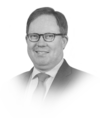Here’s why the Gulf needs more institutional investors

https://arab.news/v3r38
Institutional investors are the backbone of Western capital markets where they account for most dealing and hold a lion’s share of tradable assets. Institutions typically pool money from various sources, particularly retail investors.
Typical institutional investors include pension funds, insurers, and various fund managers. Institutions play an important role as financial intermediaries. By pooling capital, they can both reduce its cost and manage these funds better. Due to their scale, resources, and fiduciary mandates, institutions tend to increase the efficiency of capital allocation, which is important for economic development. Mobilizing capital efficiently is good for productivity and, ultimately, for growth.
Most institutions have long-term liabilities and they can predict with reasonable accuracy when they have to make payments. This allows them to offer funding with significantly longer terms than banks, which makes them a source of stability and continuity in capital markets.
While institutional investors, especially collective savings vehicles, dominate Western capital markets, their nature and scale are different in the Gulf. Gulf Cooperation Council institutions are primarily made up of various sovereign funds, some financial corporations, state-owned enterprises, and family offices. While many are substantial entities, the role of Western-style collective savings vehicles remains very modest.
The insurance sector still lags behind the global norm, while government funds dominate the pension industry. Some, typically larger, companies offer thrift schemes but these are not necessarily professionally run or regulated. Similarly, voluntary pension saving is possible through a growing number of products and platforms. But, again, this category is typically not formally regulated, especially not under a framework designed for pension savings. As a result, their capital is not necessarily managed on the same basis as conventional pension funds.
The role of collective savings vehicles is likely to remain one of the main differentiators between GCC capital markets and their Western counterparts for the foreseeable future. Government pension and social insurance funds are the second largest category of GCC institutional investors after sovereign wealth funds. Their total assets were estimated at roughly $600bn in 2020.
But their contribution to the capitalization across Gulf stock markets is only roughly five percent. Also, many public pension systems face actuarial deficits while the existing funds per citizen falls short of advanced Western economies. A 2015 survey by professional services firm EY found that GCC pension fund holdings were a quarter of the region’s gross domestic product with average holdings of some $15,000 per citizen, while the UK figure was more than four times this.
Some regional pension funds have set up dedicated asset management companies, such as Hassana in Saudi Arabia and Osool in Bahrain, to professionalize management and boost returns. By contrast, occupational pension funds or voluntary retirement schemes have a relatively marginal presence in Gulf markets, partly because of the relative absence of regulation and policy incentives.
The Gulf insurance sector has been growing at a brisk pace but remains an emerging industry. Growth to date has been heavily influenced by government regulations, such as mandatory vehicle and accident insurance and more recent initiatives in health insurance. The development of the sector has also benefited from bespoke regulations for Shariah-compliant Takaful, which helped address the traditional cultural resistance to conventional insurance.
The Gulf insurance market saw brisk annual growth of 8.9 percent from $18.4bn in 2013 to $28.2bn in 2018 but the pace has since slowed. The average insurance penetration — the value of total gross premiums as a percentage of GDP — in 2018 was around 2.3 percent which lags behind the emerging markets average of 3.2 percent, and 6.2 percent globally. Overall, insurance density – per capita premiums – in the GCC stood at $470 in 2018, albeit with considerable regional variations. The global average was almost twice this, and the advanced economy figure is roughly ten times as much.
Saudi Arabia has also proactively targeted institutional investors through a phased approach to permitting foreign ownership on its Tadawul stock market. The Kingdom’s financial regulator, the Capital Market Authority, prioritized “specialized foreign investors, with long-term investment goals in the local market,” which was seen as an opportunity to “contribute to market stability and reduce high volatility in prices.”
Following swap-based foreign access in 2008, qualified foreign investors were permitted in 2015. All these trends have begun to make a significant difference. In early 2008, individuals accounted for more than 90 percent of the value of trading on Tadawul. This share had fallen to roughly 70 percent by the spring of this year.
While foreign access is set to grow, with Gulf markets now included in international benchmark indices, significant convergence with the Western norm of institutional investor-dominated markets is likely to require much more progress to encourage long-term savings.
Such a system has to be built on comprehensive regulation, which must include prudential guidelines designed to ensure the safety and liquidity of investments. This will not only contribute to market stability, but will allow growth by putting in place powerful mechanisms for capital pooling. Such steadily expanding pools of long-term capital will, among other things, encourage more businesses to list on stock markets, helping to ease the traditional bank dominance of the Gulf’s financial systems.
Supported by appropriate risk management, asset managers can help drive the broader diversification of regional financial markets and economic diversification as funds become available for new activities and ideas. Important areas that continue to be hampered by capital constraints include startups, which are key to driving growth across the Gulf’s regional economies.
• Jarmo Kotilaine is an economist and strategist focusing on the Gulf region. He writes on issues ranging from economic development to changes within the corporate sector.










































